|
CONTENTS
Night All Star Game
Catcher's Mask
Ted's Debut
Batting Glove
Pentagonal Home Plate
3,000 K Lefty
World's Series
All-Star Brothers
Ballpark with Waterfall
More Than 100K, Fewer Than 10W
Baseball Firsts – I
Baseball Firsts – II
Baseball Firsts – III
Baseball Firsts – IV
Baseball Firsts – V
Baseball Firsts – VII
Baseball Magazine
Golden Rankings Home
Top of Page
|
Baseball
Firsts Archive - VI
Night All Star Game
The 1943 Midsummer Classic at Shibe Park in Philadelphia was the first All Star Game held at night.
- The game didn't start until 9 pm E.W.T. (Eastern War Time) in order to attract more fans who had to work during the day.
- This remains the only All-Star game in which no New York Yankee played. Joe McCarthy, the Yankee skipper who was managing his seventh All-Star game, had been criticized in past years for selecting his own players as starters. So he reacted in 1943 by not even playing any of the five Yankees on his roster.
- A crowd of 31,938 contributed $115,000 to the war effort.
- The AL won 5-3 over the Senior Circuit team managed by Billy Southworth of the St. Louis Cardinals, who started five members of his defending World Series champs.
- The NL batting leader at the break at .331, Stan Musial appeared in the first of his 24 All-Star games. The Man singled in a run in the first inning.
- The classic was played under the lights again in 1944. After cancellation in 1945, the final year of the war, the game returned to the afternoon in 1946. It was not played at night again until 1968 but has been played after dark ever since.
|
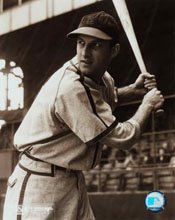 Stan Musial
Stan Musial |
 Fred Thayer,
Fred Thayer,
Alex Tyng
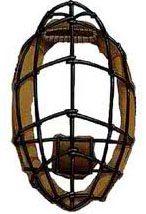
First Catcher's Mask |
April 12, 1877: The first catcher's mask was used in a Harvard game.
- Crimson player-manager Fred Thayer adapted a fencing mask for Alexander Tyng, his starting C. Tyng made only two errors in his first game with the mask, an exceptionally low number for even a professional in that era. Alex later became the first Harvard alumnus to play in a major league game (Boston Caps 1879).
- Thayer received a patent for the mask in 1878. Later in the year, A.G. Spalding and Brothers Company, the leading sporting goods dealer in the country, began selling the Thayer Catcher's Mask for $3.00.
- At first, catchers were slow to use the mask. However, sales took off in 1879 thanks to of a rule change that did away with the one bounce rule.
It was now necessary for a catcher to catch a two-strike foul tip in the air in order to record an out. With catchers moving closer to the batter in order to take advantage of this new ordinance, the catcher's mask became indispensible. (Reference below)
Before this invention, players used other means of protecting themselves.
- Some catchers wore tightly wound rubberbands around their teeth to protect from getting them knocked out.
- Cincinnati Red Stockings' founder-SS George Wright designed a mouthpiece in the 1860's. He patented it and sold it to other players.
Reference: "The Invention of the Catcher's Mask," Inside Pitch
|
April 20, 1939 @ Yankee Stadium: Ted Williams played his first game with the Boston Red Sox.
- Batting sixth and playing RF, Williams hit a double, his first major league hit, in four trips off Red Ruffing who pitched a seven-hit shutout.
- Lefty Grove also tossed a seven-hitter for Boston but lost 2-0.
- Lou Gehrig started the season at 1B but played only eight games before voluntarily ending his consecutive game streak to seek medical attention.
- Probably none of the 30,278 in attendance realized they were witnessing history – the start of the Hall of Fame career of one of the greatest hitters ever to don a baseball uniform.
- New York would win the AL pennant by 19 games, then sweep the Cincinnati Reds in the World Series. Some have pegged the '39 Yankees as the greatest team of all time.
The starting lineups that day:
Boston Red Sox
Doc Cramer CF
Joe Vosmik LF
Jimmy Foxx 1B
Joe Cronin SS
Jim Tabor 3B
Ted Williams RF
Bobby Doerr 2B
Gene Desautels C
Lefty Grove P
Manager: Joe Cronin |
New York Yankees
Frank Crosetti SS
Red Rolfe 3B
Jake Powell LF
Joe DiMaggio CF
Lou Gehrig 1B
Bill Dickey C
Joe Gallagher RF
Joe Gordon 2B
Red Ruffing P
Manager: Joe McCarthy |
|
 Ted Williams
Ted Williams

Lou Gehrig |
|
| Batting Glove |
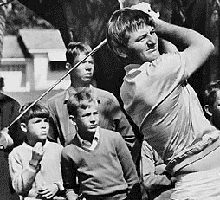 |
"Necessity
is the mother of invention" is the way Ken
"Hawk" Harrelson explained how he came to be
the first player to use a batting glove in a major league game. Playing
for the Kansas City Athletics
in 1963, Ken had a blister on his left hand from playing
27 holes of golf. In the lineup that night against left-hander Whitey
Ford of the Yankees,
Harrelson took the golf glove out of his pocket and
put it on his hand. "From that day on, I never hit again without
one."
Another
source says that the first batting glove was introduced to baseball
in 1949 by golf pro Danny Lawyer, who gave one to Bobby
Thomson of the New York Giants.
However, the gloves were used only for batting practice and spring training
until Harrelson's blister. Soon other players began
using batting gloves in games and, eventually, wore them under their
gloves on defense.
Reference:
Baseball Digest August 2007 |
Prior to 1900, home plate was a square just like the other bases. It was turned on its diagonal so that one corner coincided with the intersection of the first and third base foul lines. The front corner pointed toward the pitcher.
For the 1900 season, the owners voted to make home plate a pentagon. The bottom corner would still sit where the foul lines met, but now the front would be a rectangle rather than a triangle. While the purpose of the change was to give umpires a better view, the new shape gave pitchers more area to work the corners.
The actual calculations are as follows.
- Square home plate 12" on each side has area = 12 x 12 = 144 sq. in.
- The area of the pentagon can be computed by dividing it into a rectangle and a right triangle.
- The rectangle has area = 8.5 x 17 = 144.5 sq. in.
- The triangle's area = (12 x 12)/2 = 72 sq. in.
- So the area of the pentagon = 144.5 + 72 = 216.5 sq. in.
- So home plate increased in area 216.5 – 144 or 72.5 sq. in. from 1899 to 1900. That's a 50% increase.
|
 Pentagonal Home Plate
Pentagonal Home Plate |
|
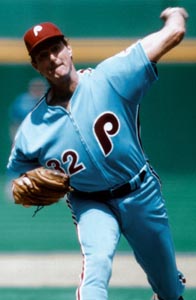 Steve Carlton
Steve Carlton |
On April 29, 1981, Steve Carlton became the first lefthander to strike out 3,000 batters when he fanned Tim Wallach of the Montreal Expos.
At that point, only five pitchers had achieved 3,000 Ks.
- Walter Johnson (1923)
- Bob Gibson (1974)
- Gaylord Perry (1978)
- Nolan Ryan (1980)
- Tom Seaver (just 11 days earlier on April 18, 1981)
Carlton ended his career with 4,136 Ks in 24 seasons.
- Lefty pitched his first seven seasons with the Cardinals. Then, in the dumbest trade St. Louis ever made, he was sent to the Phillies.
- In his first season with Philadelphia, 1972, Steve won 27 games. This was amazing since the club won only 59 games that year!
- Carlton pitched for the Phillies into the 1986 season when he was released in June. He pitched briefly for the San Francisco Giants and the Chicago White Sox that season.
- He also pitched for Cleveland and Minnesota before retiring early in the 1988 campaign.
Steve was inducted into the Hall of Fame in 1994.
|
|
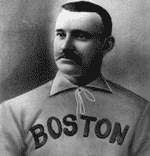
"Old Hoss" Radbourne
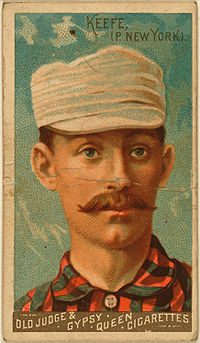
Tim Keefe
|
The standard history of baseball says that the first World Series occurred in 1903 when Boston of the American League met Pittsburgh of the National League. However, the first World's Series (note the apostrophe) took place in October of 1884.
- The Providence Grays, champions of the National League (founded 1876), met the New York Metropolitans, winners of the upstart American Association (1882).
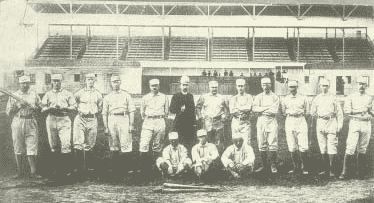
Providence Grays, 1884 National League champs.
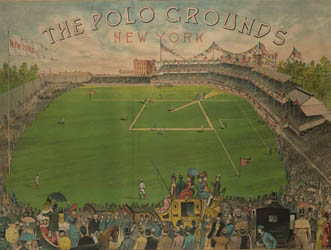
- The three-game series resulted from the challenge that the Mets' manager, Jim Mutrie, had issued his NL counterpart, Frank Bancroft.
- The agreement called for all games to be played at the Polo Grounds in New York.
In those days, teams had one ace pitcher, who threw almost every game. So the Grays' Charles "Old Hoss" Radbourne, who won 60 (some say 59) games that year, faced another future Hall-of-Famer, Tim Keefe of the Mets.
- The Grays won the first two games by 6-0 and 3-1 scores. The first game went the full nine innings, but the second was called after seven because of darkness.
- The third game didn't need to be played since the winner was determined. But the Mets hoped to earn more revenue. However, the Grays weren't interested, especially when only about 300 spectators showed up in the frigid weather that hit the area that October 25.
- The rules called for the lone umpire to be approved by both teams. The Grays decided to object to every arbiter the Mets proposed in hopes that the game would be cancelled. Finally, Mutrie told the Grays to pick an umpire. So Bancroft cannily chose Keefe, the Mets' ace.
- Providence belted New York's sub pitcher early. With the score 11-4 in the sixth inning, Keefe called the game because of darkness.
|
|

Dom and Joe DiMaggio

|
The first All-Star game was played in 1933. In 1941, the DiMaggios, Joe and Dom, became the first brothers to be teammates on an All-Star roster.
- Joe, of course, played for the New York Yankees. When the Summer Classic was played in Detroit that year, he had hit safely in 48 straight games. The streak, of course, would extend eight more games.
- Younger brother Dom was in only his second year with the Boston Red Sox. Like his brother, he patrolled CF.
- Joe, a starter, went 1-4. Dom took over in RF in the seventh and singled in his brother in the eighth.
- The game is famous for Ted Williams' three-run HR in the bottom of the ninth to give the AL a 7-5 victory. Joe had just beaten the throw to first to avoid a game-inning DP.
The first brothers to be on opposite rosters in an All-Star Game were Carlos and Lee May in 1969.
- 21-year old OF Carlos represented the Chicago White Sox in the contest at RFK Stadium in Washington. He struck out in the ninth while pinch-hitting for C John Roseboro.
- Lee, 26, of the Cincinnati Reds, was 0-1 after taking over for Willie McCovey at 1B.
- The NL took the game 9-3.
|
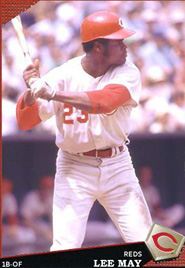 |
|
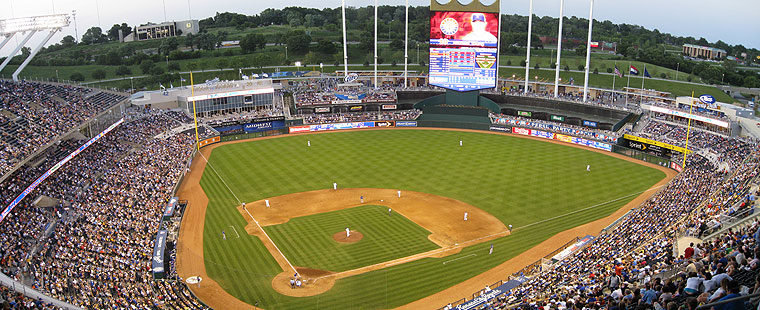
When Royals Stadium opened in 1973, it became the first ML ballpark with a waterfall.
- The park resulted from a 1967 bond issue passed by the voters of Jackson County for its construction as part of an eventual $70 million package that included the Chiefs' Arrowhead Stadium next door.
- Praised ever since as an architectural triumph in an era that produced the "cookie cutter" baseball/ football stadiums in St. Louis, Atlanta, Cincinnati, and Pittsburgh, the stadium included the waterfalls from its inception.
- Kansas City A's owner Charles Finley, rebuffed in his efforts to obtain a new park to replace Municipal Stadium, moved the team to Oakland after the 1967 season.
- U.S. Senator Stuart Symington of Missouri demanded a new franchise for K.C., or he would introduce legislation to repeal baseball's anti-trust exemption. As a result, the AL awarded the city an expansion franchise for the 1969 season.
- Royals GM Cedric Tallis worked with HOK Sports to incorporate the best parts of Dodger Stadium and Angels Stadium into the 40,793-seat park. It was the first AL park with an Astroturf surface.
- The most unique features of the stadium were the water fountains beyond the OF fence as Kansas City is known as the City of Fountains. The fountains stretch 322' horizontally and have a 10' high waterfall that descends from an upper cascade pool that serves as a background for two water fountain pools.
- In 1993, Royals Stadium was renamed Kauffmann Stadium in honor of the longtime owner of the team.
|
More Than 100 K, Fewer than 10 W
 Miguel Olivo
Miguel Olivo |
Al Blumkin of the Society for American Baseball Research discovered that C Miguel Olivo of the 2006 Florida Marlins became the first and only player to strike out more than 100 times in a season while having fewer than 10 walks. What is even more amazing, says Al, is that four of Miguel's nine walks were intentional.
- Olivo, a native of the Dominican Republic, began his MLB career with six games with the White Sox in 2002. He then played 114 games for Chicago the next season. He hit .237 with 80 K and 19 W.
- He was traded to Seattle midway through the 2004 season and then sent to San Diego during the '05 season.
- Miguel toiled for the Marlins in '07 as well as '06. Then he joined the Royals for the '08 and '09 seasons.
- Entering the 2010 campaign, his career ledger shows 683 K and only 98 W.
|
|
















